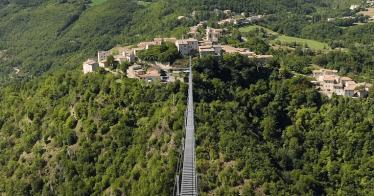HISTORY
Most probably founded by the Romans in 84 AD, the town had an important strategic function in the Middle Ages to control the Vigi River Valley: for this reason it was subjugated by the Longobards and the Duchy of Spoleto. In the 13th century it passed to the Papal States, in the 14th century it became fief of the Colligola family, lords of Montesanto, then in 1860 it voted to become part of the Kingdom of Italy.
ART AND CULTURE
In the town centre is the beautiful Palazzo Comunale, a characteristic construction from the 1500s with frescoes from the same period.
In Montesanto is the church of Santa Maria, built in the 13th century and reconstructed in the 16th century, with many paintings from the 16th and 17th centuries; an unusual pulpit completely carved in walnut; and a gold-background triptych dating from the 15th century. The church holds the mortal remains of Beato Jolo, a hermit who lived between the 13th and 14th centuries, today patron saint of Sellano.
In the vicinity there are numerous castles and works of art. Such as in Cammoro where the church of Santa Maria Novella is a rare example of a pensile church; in Montesanto there is an ancient castle encircled by walls; and in Postignano an old pensile castle from the Middle Ages surmounted by a hexangular tower. In the hamlet of Pupaggi can be seen the church of San Sebastiano, built in the 13th century and still today displaying examples of Romanesque architecture. In Sterpare, the church of the Madonna delle Grazie guards a precious wooden sculpture from the 1200s portraying the Madonna and Child. While characteristic Villamagiana has the most remunerative activity of Sellano: the manufacture of files and rasps.



























